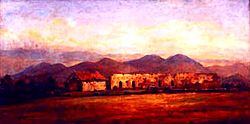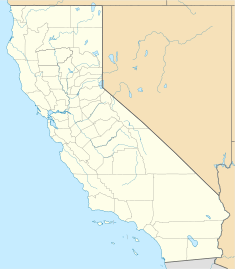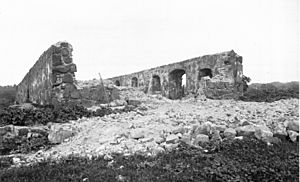Santa Margarita de Cortona Asistencia facts for kids

Misión de Santa Margarita by Henry Chapman Ford, 1881
|
|
| Location | Santa Margarita, California |
|---|---|
| Coordinates | 35°24′2″N 120°36′44″W / 35.40056°N 120.61222°W |
| Name as founded | Asistencia de la Misión de San Luis, Obispo de Tolosa |
| English translation | Sub-Mission to the Mission San Luis Obispo de Tolosa |
| Patron | Saint Margaret of Lavinio and Cortona, Italy |
| Nickname(s) | "San Luis Obispo County's Third Mission" |
| Founding date | 1787 |
| Military district | Third |
| Native tribe(s) Spanish name(s) |
Chumash Obispeño |
| Native place name(s) | Trolole |
| Governing body | Private entity |
| Current use | Unknown |
| Reference no. |
|
The Santa Margarita de Cortona Asistencia was like a small branch or "sub-mission" of the main Mission San Luis Obispo de Tolosa. It was started in 1787 when California was part of Spain. You can find its original location near the town of Santa Margarita in San Luis Obispo County, California.
Contents
Exploring the History of Santa Margarita Asistencia
This special outpost was built north of the main mission. It was in the Santa Lucia Mountains, on a spot chosen by Padre Junípero Serra way back in 1772. The place was named after Saint Margaret of Cortona, a saint from Italy. It was set up to help the many Native Americans from the Salinan (Obispeño) tribe. Their homeland included this area. The site also worked as a chapel, a storage building, and a place for people to stay.
The building was made of adobe (a type of sun-dried brick) and stone. It was about 120 feet long and 20 feet wide. It had a chapel for prayers and eight other rooms. These rooms were used by the manager, his helpers, and visiting priests. One room was a granary, which is a place to store crops like grain. The Native Americans living nearby grew a lot of grain in the fields around the asistencia.
In November 1818, a French privateer named Hipólito Bouchard attacked towns along the California coast. Many people from the area came to this inland asistencia to find safety.
Life After the Missions: The Rancho Period
In 1835, the Santa Margarita Asistencia, along with Mission San Luis Obispo, was "secularized." This means the government took control of it from the church. Like many mission properties, it was not well cared for after this change. In 1841, a large piece of land called Rancho Santa Margarita was given to Joaquín Estrada by the Mexican government.
After American forces captured Monterey in 1842, two important generals, Pío Pico and José Castro, met at the rancho. They talked about their plans. During the 1846 Bear Flag Revolt, Captain John C. Frémont's soldiers caught a Native American carrying a message at the rancho. Frémont ordered the man to be executed. In December of that same year, Frémont also arrested Estrada and others at the rancho. He let them go only after they promised to help him.
In 1861, Estrada sold Rancho Santa Margarita to Mary and Martin Murphy Jr. The Murphys had traveled to California in 1844. They gave the job of running this rancho, and two others they owned, to their son Patrick W. Murphy. Patrick later served in the California government. He built a large barn over the old adobe and stone Santa Margarita de Cortona Asistencia. This helped protect the historic building from the weather.
In February 1889, the town of Santa Margarita officially became a town.
What's Left Today?
The Santa Margarita de Cortona Asistencia site is now a California Historical Landmark. This means it's a very important historical place in California. Some of the original stone walls are still standing today. They have been made part of a ranch barn. The site is on private land that belongs to the Santa Margarita Ranch. Sometimes, tours are offered, and you might be able to visit during special public events held at the Ranch.
See also



